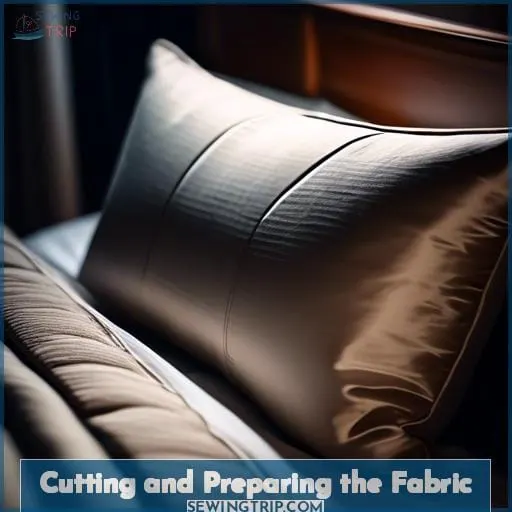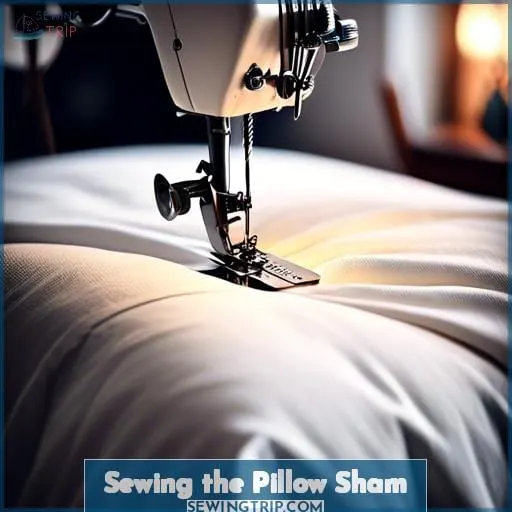This site is supported by our readers. We may earn a commission, at no cost to you, if you purchase through links.
 Like a master painter with a blank canvas, you’re about to transform simple fabric into a work of art.
Like a master painter with a blank canvas, you’re about to transform simple fabric into a work of art.
Sewing a flanged pillow sham with mitered corners is not just about creating a functional item, but it’s an expression of skill and precision.
This guide will walk you through selecting the perfect materials, cutting with accuracy, and sewing with finesse to achieve those crisp, clean mitered corners that frame your pillow like a masterpiece.
Get ready to infuse your space with a touch of elegance as you master the art of the flanged pillow sham.
Table Of Contents
Key Takeaways
- Utilize natural fibers like cotton and linen for their durability and breathability, which are essential for a comfortable and long-lasting pillow sham.
- Interfacing is crucial for maintaining the structure and sharpness of the flanges and mitered corners, so select the weight that complements the fabric.
- Precision in measuring, cutting, and ironing is key to ensuring a proper fit and neat finish, especially when creating mitered corners for a professional look.
- The envelope back panel design is not only practical for pillow insertion and removal but also contributes to the overall neatness and functionality of the pillow sham.
Understanding Mitered Corners
Mitered corners are a sewing technique that creates a polished, professional finish on various projects, including flanged pillow shams.
They involve beveling two pieces at 45° angles to form a precise, clean 90° corner, which reduces bulk and allows edges to meet evenly.
This method is particularly beneficial for pillow shams, adding an element of sophistication and a tailored look to your bedding.
By understanding how to execute mitered corners effectively, you can enhance the overall appearance of your pillow shams, making them not only elegant but also neatly finished.
Definition and Importance
Understanding mitered corners is like unlocking a secret chamber of sewing wizardry, especially when it comes to elevating your pillow sham game. These corners aren’t just about sharp angles; they’re the cornerstone of creating that crisp, picture-perfect finish that screams I know what I’m doing.
Think of mitered corners as the cherry on top of your DIY flange techniques sundae. They transform a simple flange into a masterpiece of precision and style. Whether you’re a seasoned seamstress or a DIY newbie, mastering mitered corners will catapult your pillow shams from homemade to handmade with a capital H.
And let’s not forget the fabric selection tips and interfacing options that go hand in hand with these corners. Choosing the right fabric and interfacing can make or break your project, but get it right, and you’re on your way to creating custom, creative flange designs that add a personal touch to any bedroom.
So, grab your fabric, DIY spirit, and let’s dive into the world of mitered corners and flanged pillow shams.
Benefits for Pillow Shams
In the cozy world of home decor, mitered corners on flanged pillow shams are like the cherry on top of a sundae – they just make everything look better.
Imagine transforming your guest bedroom with these elegant touches; it’s like giving the room a mini facelift. These corners aren’t just about good looks, though. They’re a testament to your sewing savvy and attention to detail.
Plus, let’s not forget the customization factor – you’re the maestro, choosing the perfect home decor fabric to match your vision. And if you’re thinking of gifting, a handmade flanged pillow sham with those crisp mitered corners is like wrapping up durability and versatility in one neat package.
So, grab your fabric, and let’s add that sophisticated edge to your pillow projects!
Selecting Materials
Choosing the right materials is crucial for sewing a flanged pillow sham with mitered corners.
Select the appropriate interfacing to add stability and shape to your project.
Choosing the Right Fabric
After mastering mitered corners, it’s time to dive into the world of fabrics for your pillow sham project. Choosing the right fabric is like picking the perfect outfit—it sets the tone for your bedroom’s style.
Think of fabric types as the characters in your decor story, with pattern matching as the plot twists that keep things interesting. You’ll want to select a fabric that not only looks good but will stand the test of time, especially if you’re crafting a flange that frames your pillow sham like a work of art.
When it comes to color schemes, it’s like mixing paint on a palette—aim for harmony or a delightful contrast that pops. Don’t forget to tap into online resources; they’re treasure troves of inspiration and guidance.
And of course, a visit to local fabric stores can be as exciting as a kid in a candy shop, with textures and hues that beg to be touched and seen in person.
Importance of Interfacing for Stability
When you’re sewing a mitered corner pillow sham, interfacing is your secret weapon for crisp, stand-at-attention flanges. Think of interfacing as the spinach to your Popeye—it gives your fabric the muscle to perform feats of strength, like maintaining a sharp edge.
You’ve got options galore: fusible interfacing for a quick stick, non-fusible for a traditional sew-in approach, and varieties like woven or knit to match your fabric’s flex. So, grab that interfacing, press it on, and watch as your pillow sham flanges go from limp to lively, ready to frame your pillow with the poise of a Buckingham Palace guard.
Cutting and Preparing the Fabric
To kick off the process of cutting and preparing the fabric for your flanged pillow sham with mitered corners, you’ll first need to measure and cut your fabric pieces accurately. This step is crucial for ensuring that your pillow sham fits perfectly and looks professional.
Next, prepare your flanges and interfacing, which will add structure and definition to your sham, making it stand out as a sophisticated addition to your bedroom decor.
Measuring and Cutting Fabric Pieces
Once you’ve picked out the perfect fabric, it’s time to get down to brass tacks with your measuring tape and scissors. Precision is your best friend here; a smidge off can lead to a wonky pillow sham that just won’t sit right.
Start by laying out your fabric on a flat surface, smoothing out any wrinkles that might throw off your measurements. You’ll want to cut your fabric pieces to size, factoring in those all-important seam allowances to ensure your pillow sham fits like a glove.
Now, don’t forget about the interfacing. This unsung hero gives your flanges that crisp, stand-at-attention look. Choose an interfacing that complements the weight of your fabric to avoid a floppy or overly stiff appearance.
Cut it just as carefully as your fabric pieces to ensure it fuses properly and supports those sharp mitered corners.
Preparing Flanges and Interfacing
Alright, let’s dive into the nitty-gritty of flange sizing and interfacing weight, shall we? You’re about to become a flanged pillow sham wizard, with mitered corners so sharp they could practically cut through the tension of a thriller movie climax.
- Measure Twice, Cut Once: For flanges that don’t flop, measure your pillow sham and add the desired width of your flange times two, plus seam allowances. Precision is your best friend here.
- Pick Your Interfacing: Choose interfacing weight that’s the Goldilocks of fabric blending—not too stiff, not too floppy. It should whisper stability without screaming rigidity.
- Fabric Sourcing Fun: Embark on a fabric sourcing treasure hunt. Whether it’s the local fabric store or the digital aisles of Etsy, find that perfect match. Remember, color matching is key to a harmonious bedroom symphony.
Now, iron on that interfacing with the finesse of a seasoned chef flipping pancakes, and you’re on your way to creating a masterpiece that’s both cozy and chic.
Sewing the Pillow Sham
Once you’ve attached the flanges to the front panel, it’s time to construct the envelope back panel for your pillow sham.
This step is crucial for creating a sham that not only looks professional but also functions well, allowing for easy insertion and removal of the pillow form.
Attaching Flanges to the Front Panel
After you’ve measured and cut your fabric pieces, it’s time to attach the flanges to the front panel of your pillow sham. This step is where your sham begins to take shape, and your choice of fabric for the flanges can add a personal touch to your creation.
Whether you opt for a subtle elegance or a bold statement, the flange size variations allow you to tailor the look to your preference.
For a crisp, professional finish, consider using interfacing to give your flanges that extra bit of structure. When attaching the flanges, ensure they’re evenly placed and securely attached to the front panel.
This will set the stage for the mitered corners that will elevate the sophistication of your pillow sham. Remember, the devil is in the details, so take your time to ensure each flange is perfectly aligned and sewn with precision.
Your pillow sham isn’t just a place to rest your head but a reflection of your sewing prowess and attention to detail.
Constructing the Envelope Back Panel
To construct the envelope back panel of your pillow sham, you’ll be channeling your inner seamstress to create a hidden pocket for your pillow form.
- Start with the Fabric: Cut two pieces of fabric for the back panel, each piece should be the width of your pillow plus the seam allowance, and about half the height plus some overlap.
- Hem the Edges: Hem one long edge of each back panel piece. This will be the edge that creates the envelope opening, so make it neat!
- Layer and Align: Place the front panel of your sham right side up, then lay the back panel pieces on top, right sides down, with the hemmed edges overlapping in the middle.
- Stitch Together: Sew around the perimeter, securing the back panels to the front. Remember to include your seam allowance for a snug fit around the pillow form.
Once you’ve sewn all around, turn the sham right side out, and voilà, you’ve got an envelope-style back that’s as slick as a French welt on a custom soft furnishing. It’s the perfect touch for your one-room makeover, adding that personal flair without the fuss.
Creating and Finishing Mitered Corners
Creating and finishing mitered corners on a flanged pillow sham elevates the overall look, giving it a professional and polished appearance.
You’ll learn to precisely fold and sew the fabric at 45-degree angles, ensuring your pillow shams have crisp, clean corners that add a touch of sophistication to any bedroom decor.
Step-by-step Mitering Process
After attaching your flanges to the front panel, it’s time to tackle those mitered corners. You’re not just making a pillow sham; you’re crafting a masterpiece of fabric and thread. So, let’s dive into the mitered corner techniques that’ll make your sham stand out.
First, you’ll need to fold the corners of your flanges at a precise 45° angle to meet the cozy embrace of a 90° corner. It’s like origami with fabric, where every fold and crease counts. Remember, the fabric selection impact is real; a sturdy cotton will hold that crisp corner like a champ.
Don’t forget the interfacing usage. It’s the unsung hero that gives your flanges the backbone they need to stand tall and proud. It’s like a secret agent working behind the scenes to ensure everything looks sharp and stays in place.
Now, for the envelope back panel design, it’s all about the overlap. Think of it as a secret handshake between the fabric pieces, ensuring the pillow form stays snug without any peek-a-boo moments.
Finally, pillow form insertion methods are the grand finale. It’s like a Cinderella moment for your pillow, slipping into its sham with a perfect fit. And voilà, you’ve just turned a bunch of fabric into a flanged pillow sham with mitered corners that could make a professional seamstress nod in approval.
Final Assembly and Inserting the Pillow Form
After mastering the mitering process, you’re ready for the grand finale: assembling your flanged pillow sham and nestling the pillow form snugly inside.
- Begin by aligning and pinning the back and front panels of your sham, right sides together, ensuring your mitered corners are crisp.
- Sew around the perimeter using the seam allowances you’ve carefully calculated, leaving an opening for the pillow form.
- Turn the sham right side out, poking out the corners to showcase your corner stitching handiwork.
- Insert the pillow form, finessing it into place for that plump, inviting look. If you’ve opted for an envelope-style hidden closure, tuck the back flaps neatly over the pillow.
- Finally, give your sham a once-over with the iron for a polished finish, and voilà! Your custom, DIY flanged pillow sham with mitered corners is a testament to your sewing savvy and a chic addition to any room.
Frequently Asked Questions (FAQs)
How do you wash a flanged pillow sham without damaging it?
To wash a flanged pillow sham without damage, first check the fabric care label.
If machine washable, use a gentle cycle with cold water and mild detergent. Avoid bleach.
For cotton shams, tumble dry on low or air dry to prevent shrinking.
Iron on a low setting if needed for a crisp appearance.
Can you add piping to a flanged pillow sham for extra detail?
Absolutely, you can jazz up a flanged pillow sham with piping for that extra zing! It’s like adding a necklace to a little black dress—suddenly, it’s not just any outfit.
Piping can frame your sham beautifully, giving it a crisp, defined edge that screams custom-made. Just sew it in along the seam where your flange meets the main body of the sham.
It’s a game-changer, trust me!
What are the best fabrics for a flanged pillow sham that will be used daily?
For a flanged pillow sham that’ll hug your dreams nightly, cotton’s your go-to for its softness and resilience.
But don’t stop there; mix it up with linen for a breezy feel or silk for a touch of luxury.
They’re not just fabrics; they’re your canvas for comfort and style.
How do you adjust the flange size for a larger or smaller pillow sham?
Looking to size up or down your pillow sham’s flange? Simply alter the cut fabric strips to your desired width plus seam allowances—easy peasy!
To adjust the size of your pillow sham’s flange, modify the width of the fabric strips you cut. Include seam allowances in your measurements. This simple change allows for easy customization of your pillow sham’s flange size.
Can a flanged pillow sham be modified to include a zipper closure instead of an envelope back?
Absolutely, you can jazz up a flanged pillow sham with a zipper closure for a sleek look and easy pillow switcheroo.
Conclusion
Ah, the grand finale of your flanged pillow sham with mitered corners is upon us!
You’ve navigated through the labyrinth of fabric and thread, emerging victorious with a creation that’s nothing short of a plush throne for your head.
Now, as you stand back and admire your handiwork, remember that this isn’t just a pillow sham—it’s a testament to your sewing prowess.
With each stitch, you’ve not only crafted a beautiful piece but also honed your skills.
So fluff up that pillow and let it showcase your mastery of the flanged pillow sham with mitered corners.
Your living space is now graced with a touch of handmade elegance, and you, my friend, are the artist behind it.











